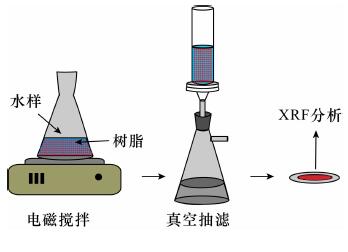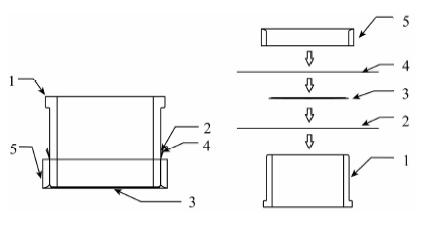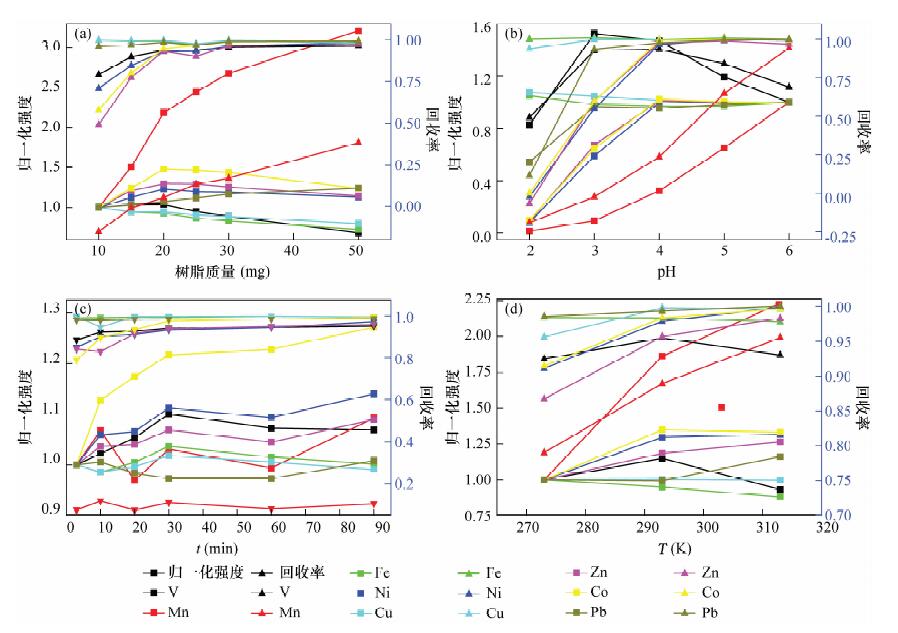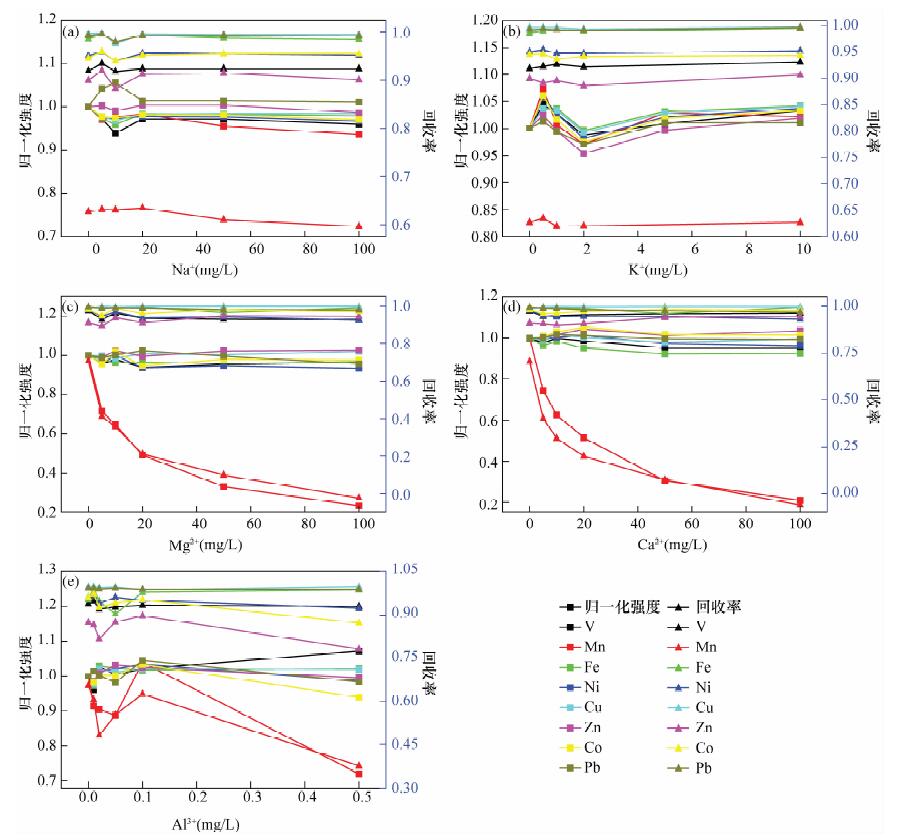Portable EDXRF Analysis of Eight Heavy Metals in Environmental Water Using Pre-concentration with Purolite S930 and Thin-layer Sample Technique
-
摘要: 使用便携式X射线荧光光谱法结合富集技术已能分析液体样品中近20种金属元素, 但检出限相对较高(0.1~100 μg/L)、富集操作繁多、一种富集法可测元素种类较少等因素制约了该技术的发展.本文研究了一种适应于现场测试环境水样的XRF分析方法.使用20 mg S-930螯合树脂对100 mL水体中8种重金属(V、Mn、Fe、Co、Ni、Cu、Zn和Pb)进行预富集, 控制溶液pH=4, 搅拌30 min, 经真空抽滤系统过滤制得均匀薄样, 再使用自制的双层膜包夹样品盒并利用小型台式波长色散XRF测定.结果表明, 8种元素标准曲线的相关性R2>0.997, 检测范围为10~1000 μg/L, 检出限为1.0~6.2 μg/L, 方法精密度(RSD, n=12) 小于5%, 加标回收率为80%~120%;标准水样和模拟水样的测定结果分别与标准值和理论值基本一致.本方法巧妙地使用双层聚丙烯膜包夹薄试样的制样方法, 较好解决了薄膜样品的污染等问题, 简化了水样的预富集操作, 制备的树脂薄样可直接供XRF测量.方法检出限较低, 稳定性较好, 适用于检测Ⅰ~Ⅴ类水体中Fe、Co、Ni和Cu, Ⅱ~Ⅴ类水体中V和Zn, Ⅲ~Ⅴ类水体中Mn和Pb, 基本具备对8种重金属污染水体进行环境监测、水质调查等现场分析的能力.
 Abstract: Analysis of environmental water samples is primarily conducted in the laboratory, which costs considerable time and money. Pre-concentration methods coupled with portable X-ray Fluorescence (XRF) have been developed for the determination of almost twenty kinds of heavy metals, but with a relatively high detection limit, complex operation, and less element types can be measured using one pre-concentration strategy. All of these problems restrict the development of the technique. To solve these issues an on-site-oriented rapid and convenient analysis method of heavy metal ions in aqueous solutions has been developed utilizing a bench-top type portable Energy-Dispersive X-ray Fluorescence (EDXRF). Based on pre-concentration with purolite S930 chelating resin and thin-layer sample preparation technique, the method could determine trace V5+, Mn2+, Fe3+, Co2+, Ni2+, Cu2+, Zn2+ and Pb2+ in environmental water samples. After the heavy metal ions have been absorbed by 20 mg of S-930 resin powder for about 30 min in the pH=4 solution, the resin powders are filtrated onto a 0.45 m filter to form a thin-layer sample which can be directly measured by EDXRF using a homemade double polypropylene film sample cup. With an amount of 100 mL of solution, the linear ranges were 10-1000 g/L and the correlation coefficients of the calibration curves were good (R2>0.997) for all the eight elements. The lower limit of detection was between 1.0 and 6.2 g/L. Precision tests carried out on multi-element mixed solutions showed that the relative standard deviations (RSD, n=12) were better than 5% except for those of Zn and Pb at the concentration level of 20 g/L. Most of the recoveries were 80%-120% with spikes of 20 g/L for each element. The analysis results of DW standard substances and simulation samples were consistent with reference values and the theoretical value respectively. This method skillfully uses a double polypropylene membrane preparation method to make a thin-layer film sample which solves the pollution problem and simplifies the pre-concentration steps. The resin film samples can be directly measured by XRF. A lower detection limit and better stability make the method suitable for a spot investigation, water quality monitoring, and assessment of Fe, Co, Ni, Cu, V, Zn, Mn and Pb in heavy metal polluted environmental water.
Abstract: Analysis of environmental water samples is primarily conducted in the laboratory, which costs considerable time and money. Pre-concentration methods coupled with portable X-ray Fluorescence (XRF) have been developed for the determination of almost twenty kinds of heavy metals, but with a relatively high detection limit, complex operation, and less element types can be measured using one pre-concentration strategy. All of these problems restrict the development of the technique. To solve these issues an on-site-oriented rapid and convenient analysis method of heavy metal ions in aqueous solutions has been developed utilizing a bench-top type portable Energy-Dispersive X-ray Fluorescence (EDXRF). Based on pre-concentration with purolite S930 chelating resin and thin-layer sample preparation technique, the method could determine trace V5+, Mn2+, Fe3+, Co2+, Ni2+, Cu2+, Zn2+ and Pb2+ in environmental water samples. After the heavy metal ions have been absorbed by 20 mg of S-930 resin powder for about 30 min in the pH=4 solution, the resin powders are filtrated onto a 0.45 m filter to form a thin-layer sample which can be directly measured by EDXRF using a homemade double polypropylene film sample cup. With an amount of 100 mL of solution, the linear ranges were 10-1000 g/L and the correlation coefficients of the calibration curves were good (R2>0.997) for all the eight elements. The lower limit of detection was between 1.0 and 6.2 g/L. Precision tests carried out on multi-element mixed solutions showed that the relative standard deviations (RSD, n=12) were better than 5% except for those of Zn and Pb at the concentration level of 20 g/L. Most of the recoveries were 80%-120% with spikes of 20 g/L for each element. The analysis results of DW standard substances and simulation samples were consistent with reference values and the theoretical value respectively. This method skillfully uses a double polypropylene membrane preparation method to make a thin-layer film sample which solves the pollution problem and simplifies the pre-concentration steps. The resin film samples can be directly measured by XRF. A lower detection limit and better stability make the method suitable for a spot investigation, water quality monitoring, and assessment of Fe, Co, Ni, Cu, V, Zn, Mn and Pb in heavy metal polluted environmental water. -
直读光谱分析是一种固体样品直接分析技术,样品制备简单,分析速度快,多元素同时检测,准确度和精密度良好,特别是火花光源放电温度很高,激发和离子化能力强,可以用于难激发非金属元素如C、S、P、N、O等元素的分析,因而直读光谱分析技术得到了不断发展[1, 2, 3]。目前直读光谱分析是金属材料化学成分快速分析的一种主要方法。例如,李政军等[4]分析锡锭中的砷铁铜铅铋锑镉锌铝等9种元素,认为试样制备简单,避免了污染,分析速度快;王军学[5]分析了高铝稀土锌合金中合金元素和杂质元素的含量,方法制样简单,结果与国家标准方法相符;温才云等[6]对国内外汽车零部件轻合金材料铝合金、镁合金的化学成分进行测试,速度快、操作简便;骆有健等[7]采用增加了氧元素的测定,快速准确地测定了阳极铜中19种杂质元素,并可计算出主成分铜的含量。直读光谱分析已在质检系统、钢铁冶金、汽车机械及涉及金属材料等行业得到了广泛应用。
电火花直读光谱法对分析样品的平面大小有一定的要求,一般要求试样的平面直径大于Φ12 mm(不同的仪器型号会有所不同)。带小样品专用夹具的直读光谱仪一般可以分析直径大于3 mm的圆棒试样,已有直接分析细小直径样品的报道[8, 9, 10, 11]。本文作者在实际样品分析中发现,圆棒试样直径的大小对各元素分析结果产生不同程度的影响,有的元素产生正影响,有的元素产生负影响,有的元素基本没有影响。为了确定具体的影响情况,选用的样品要含有多种不同性质的元素。本文选用合金钢样品,其中含有碳硫硅锰磷铬镍铜钼钒锡等元素,在同一块热轧合金钢厚板上制备直径(Φ)为25、12、8、6、4、3、2 mm的系列试样,进行直读光谱分析,考察了圆棒试样直径对测定结果的影响,并验证运用曲线插入法对测定结果进行校正的可行性。
1. 实验部分
1.1 仪器及工作条件
SPECTROLAB直读光谱仪(德国斯派克分析仪器公司):帕邢-龙格结构,光栅焦距750 mm,罗兰园,分析波长范围 120~800 nm,充氮气紫外光学系统(UV-PLUSTM)用于分析小于230 nm的波长。全息微晶石英3600条/mm光栅、2924条/mm光栅,倒线色散率分别为0.37 nm/mm(1级光谱)、0.46/ 0.23 nm/mm(1/2级光谱)。光源方式:高能预燃放电火花,采用组合光源分步积分方式。激发腔氛围:高纯氩气(经净化),压力0.7 MPa,待机氩气流量5 L/h,恒定流量25 L/h,分析流量180 L/h。激发条件:圆锥形钨对电极,直径Ф6 mm,锥角成90°,分析极距3.4 mm,冲洗时间2 s,预燃时间共6 s,分步曝光时间总计13 s,火花台台板开孔Ф12 mm。工作环境:相对湿度60%,温度23℃,温度变化≤(0.5℃/h。SPECTRO分析软件(Spark Analyzer Vision)。SPECTRO公司配备的“小样品专用夹具”。线切割机床(苏州三光科技公司)。
分析元素及测定范围见表 1。
表 1 分析元素及测定范围Table 1. Analytical element and its determination range分析元素 分析线
(nm)内参比线
(nm)测定范围
(%)组合光源 C 165.812Ⅰ Fe1 163.5Ⅰ 0.00050~2.50 火花放电1 Si 288.160Ⅰ Fe3 282.3Ⅰ 0.00060~1.60 火花放电3 Mn 293.306Ⅱ Fe3 297.1Ⅱ 0.00020~1.50 火花放电3 P 178.287Ⅰ Fe1 217.8Ⅰ 0.00030~0.150 火花放电1 S 180.731Ⅰ Fe1 217.8Ⅰ 0.00020~0.330 火花放电1 Cr 312.260Ⅱ Fe3 297.1Ⅱ 2.00~30.00 火花放电3 Ni 231.604Ⅱ Fe1 163.9Ⅱ 0.00040~1.00 火花放电3 Mo 281.615Ⅱ Fe3 239.1Ⅱ 0.00080~2.50 火花放电3 Cu 324.754Ⅰ Fe3 281.3Ⅰ 0.0001~0.20 火花放电2 V 310.230Ⅱ Fe2 297.1Ⅱ 0.0002~0.60 火花放电2 Al 396.153Ⅰ Fe3 281.3Ⅰ 0.00010~0.300 火花放电3 Co 345.351Ⅰ Fe3 281.3Ⅰ 0.000040~0.100 火花放电2 Sn 147.515 Ⅰ Fe4 149.7Ⅰ 0.0002~0.20 火花放电4 1.2 标准物质和试样
校准曲线标准物质:低点采用00-RE12,高点采用03-RN19(仪器随机标准物质)。
高合金钢(Cr13)标准物质:GBW 01608、GBW 01609(Φ32 mm×32 mm)。
试样来自同一块热轧合金钢板(厚度40 mm),制备成直径为Φ25、12、8、6、4、3、2 mm的实际样品,高度为40 mm。
60目氧化铝砂轮片和耐水砂纸。
1.3 实验方法
试样表面先用砂轮磨平,再用耐水砂纸磨光,使用直读光谱仪,利用随机配备的固定校准曲线和高低两点块状标准物质进行标准化,选择基体校正模式进行分析。
2. 圆棒试样直径的影响
2.1 圆棒试样直径对元素分析的影响
将Φ25、12、8、6、4、3、2 mm系列圆棒试样,进行直读光谱分析。Φ25 mm试样可以完全封住火花台台板开孔,其结果可以代表整块钢板的检测结果;Φ3 mm试样放电断断续续,但还是可以完成激发;Φ2 mm试样太小,预燃后间隙会明显变大,导致不能激发。预燃过程后,试样的温度随着直径的减小而剧烈升高,预燃后试样两端形成的亚结构区域明显变长,样品表面的烧蚀痕迹也越来越明显,其形貌如图 1所示。
采用铁作为内参比元素,试样的分析结果列于表 2。从表 2可以看出,Φ12 mm试样的结果与Φ25 mm基本一致,因而也可以代表整块钢板的检测结果,原因是Φ12 mm的样品刚好能封住火花台台板开孔,效果与Φ25 mm的一样。随着圆棒试样直径的变小,各元素的分析结果发生了变化,C、S、Mn、P、Cr、Ni、Cu、Sn的结果变大,Si的结果略变小,Mo、V的结果明显变小,而且发生变化各元素的变化程度不一样。可见,采用电火花直读光谱法直接分析圆棒试样时,试样直径的大小会对各元素测定结果产生不同程度的影响。
表 2 圆棒试样的分析结果Table 2. Analytical results of round-bar specimens直径
(mm)各元素的含量
(%)C S Si Mn P Cr Ni Mo Cu V Sn Φ25 0.885 0.0029 0.920 0.528 0.0146 7.702 0.103 2.51 0.060 0.513 0.0018 Φ12 0.889 0.0027 0.921 0.532 0.0144 7.704 0.101 2.50 0.061 0.513 0.0017 Φ8 0.931 0.0034 0.924 0.541 0.0167 7.749 0.104 2.37 0.064 0.512 0.0023 Φ6 0.950 0.0033 0.908 0.547 0.0168 7.898 0.104 2.23 0.067 0.501 0.0026 Φ4 0.977 0.0037 0.894 0.579 0.0171 7.942 0.111 2.05 0.073 0.468 0.0033 Φ3 1.005 0.0044 0.904 0.585 0.0194 7.972 0.116 1.81 0.083 0.465 0.0040 2.2 圆棒试样直径影响的原因分析
2.2.1 引起圆棒试样温度的变化
从图 1可以看出,随着圆棒试样直径的变小,样品温度明显发生了变化。Φ25 mm的试样激发时,试样温度基本不变,试样直径越小,试样温度升高越快,因而随着直径的变小,所有元素的挥发性能都会有所改善的。然而随着温度的升高,从易挥发元素到难挥发元素,影响的程度是不同的。
2.2.2 引起火花放电等离子体的变化
随着圆棒试样直径的变小,火花放电产生的等离子体状态会发生变化。①放电的气体氛围发生了变化。Φ25 mm的试样可以完全封住火花台台板开孔,不需要用小样品专用夹具,激发时完全是氩气氛围。Φ12 mm以下的试样需要用小样品专用夹具,激发时无法把夹具内的空气吹扫干净,因而两者的放电气体氛围是不一样的。使用小样品专用夹具对亲氧元素的测定会有影响。②等离子体的放电发生了变化。随着圆棒试样直径的变小,激发光斑单位面积单位时间的电子数不同,会直接影响到分析元素的解离、原子化、激发和电离,从而导致各元素的信号发生变化,同时激发有可能在侧面发生,使放电性能和重复性等会受到影响。因而,随着圆棒试样直径的变小,火花放电的变化会对各元素的激发性能会发生变化。
2.2.3 各元素结果变化的原因分析
直读光谱分析一般采用内标法分析,本文是以铁作为内参比元素。
P、S、Sn是易挥发元素,内参比元素Fe是中等挥发元素,试样直径越小,激发时温度上升越高,亚结构区域明显变长,更有利于提高易挥发元素的浓度,使分析结果偏大。
Mn、Cr、Ni、Cu、Si是中等挥发元素,内参比元素Fe也是中等挥发元素,对挥发性能的影响有明显的补偿作用,然而Mn、Cr、Ni的分析线都是离子线,它们的电离能都比Fe低,所以随着圆棒试样直径的变小,Mn、Cr、Ni的分析结果稍微偏大;Cu的分析线是原子共振线,从激发性能分析更有利于铜的激发,因而其分析结果明显变大;Si的分析线也是原子线,但不是原子共振线,随着直径变小,分析结果有偏小的趋势,但它们的极差只有0.030%,按GB/T 11170—2008标准(极差为0.026%),结果变化不大,主要是由于Si的分析线与Fe的内参比线各性能基本一致,有效补偿的结果。
Mo、V都是难挥发元素,特别是Mo的沸点为4804℃,很难挥发,它们的分析线都为离子线,虽然随着试样直径的变小,挥发性能有所改善,但远不如内参比元素改善明显,所以作为中等挥发元素Fe不能有效补偿Mo、V挥发性能的变化,因而使分析结果偏小,其中Mo的结果变化更为明显。
C如Mo、V元素,也是难挥发元素,然而在钢铁中碳主要以铁的碳化物和合金元素的碳化物形态存在,如Fe3C熔点只有1837℃,挥发性能发生了变化,部分属易挥发的范围,因而碳的分析结果是偏大的。
3. 分析结果的校正
利用块状样品制作的校准曲线进行线材、丝状样品的分析,有优化光源参数的方法,也有利用相同试样直径的标准物质标准化的方法,本文提出采用曲线插入法的校正方法。由表 2可知,随着圆棒试样直径的变小,各元素的分析结果是变化的。本文选择较有代表性的Mo元素来阐明。将表 2的Mo元素分析结果绘图,如图 2所示。
根据图 2可以看出,Φ12 mm试样的结果与Φ25 mm一致,都可以代表整块钢板的检测结果。随着试样直径的变小,Mo的结果基本呈线性下降。因而,如果是Φ5 mm的试样,其结果下降的程度可以采用曲线上Φ6 mm和Φ4 mm试样下降程度的均值,然后进行校正得到。
本文分析了Φ5.5 mm不锈钢试样中Mo的结果。直读光谱分析结果为1.79%,从曲线上可以算出Φ6 mm试样的校正因子为1.12,Φ4 mm试样的校正因子为1.22,采用曲线插入法计算出Φ5.5 mm校正因子为1.15,因而校正后Mo报出结果为2.06%。按SN/T 2718—2010采用电感耦合等离子体发射光谱法进行分析,Mo的测定结果为2.00%。按t检验法,两个结果无显著性差异。
本文还对其他待测元素的结果校正进行了验证。把标准物质(GBW 01608)制成Φ4 mm的细棒,当作试样进行激发,按表 2中Φ4 mm的结果与Φ25 mm的结果计算校正因子(f),校正结果列于表 3。根据表 3的R分析(R为GB/T 11170—2008中规定的实验室间允差),把标准物质当作样品激发校正后的结果,与标准物质标准值的绝对差值都小于R,说明采用曲线插入法的校正方法是可行的。
表 3 标准物质分析Table 3. Analysis results of certified reference materials项目 各元素的含量(%) C S Si Mn P Cr Ni Mo Cu V 标准物质的测定值 0.386 0.0079 0.715 0.806 0.0309 9.70 0.528 0.191 0.423 0.193 校正因子(f) 0.9059 0.7871 1.0299 0.9120 0.8551 0.9698 0.9293 1.3124 0.8165 1.0965 校正后的报出值 0.350 0.0062 0.736 0.735 0.0264 9.40 0.490 0.250 0.345 0.211 标准物质的标准值 0.340 0.0054 0.772 0.740 0.0262 9.37 0.461 0.244 0.374 0.201 报出值与标准值的绝对差值 0.010 0.0008 0.036 0.005 0.0002 0.03 0.029 0.006 0.029 0.010 实验室间允差(R) 0.063 0.0023 0.042 0.040 0.0044 0.26 0.046 0.018 0.030 0.017 4. 结语
本文选择了合金钢样品,研究了直径Φ3 mm以上圆棒试样的直径变化对直读光谱分析结果的影响。随着试样直径的变小,C、S、Mn、P、Cr、Ni、Cu、Sn元素的测定结果偏大,Si的结果略变小,Mo、V的结果明显偏小,各元素测定结果的变化与其挥发性和存在形态相关。为了能够得到准确的直读光谱分析结果,本文提出了采用曲线插入法的校正方法对测定结果进行校正,较好地解决了存在的问题。该方法适用于直径Φ3 mm以上圆棒试样的直接分析,对小截面实际样品的分析具有指导作用和实际意义。当然,本文仅研究了合金钢样品的情况,对不同钢种或不同基体试样直径的影响有待进一步研究。
致谢: 感谢国家地质实验测试中心邓月金研究员提供的DW1~DW4系列标准物质和马天芳老师提供的农田水样。感谢评审专家对本文提出的宝贵意见。 -
表 1 多元素混合标准储备液浓度
Table 1 Concentration of the multielement calibration standard solutions
元素 浓度(μg/L) Std-1 Std-2 Std-3 Std-4 Std-5 Std-6 Std-7 Std-8 Std-9 Std-10 Std-11 Std-12 V 25 10 5 1000 750 500* 250 100 75 50 50* 500 Mn 500 250 100 75 50* 25 1500 1250 1000 750 50 500* Fe 1000 750 500 250 100 75 50 25 2000 1500 50* 1200 Co 600 400 200 100 50 25 5 1250 1000 800 50* 500* Ni 5 1000 750 500 250 100 75 50 25 10 50* 500* Cu 1500 1250 1000 750 500 250 100 50 25 5 50* 1100 Zn 50* 25 5000 2500 1500 1000 750 500 250 100 50 2000 Pb 20 10 5 2 600 150 100 50 200 400 300 500 ∑i 4525 4245 7835 5287 3880 3175 3605 3785 4830 4715 650 6800 注:“*”为标准曲线中未使用的浓度值。 表 2 EDXRF仪器分析条件
Table 2 Working conditions of the EDXRF instrument
元素 分析线 能量范围
(keV)电压
(kV)电流
(μA)测量时间
(s)X射
线管过滤片 V Kα 4.854~5.054 30 260 400 Rh靶 Al Mn Kα 5.796~6.008 30 260 400 Rh靶 Al Fe Kα 6.302~6.526 30 260 400 Rh靶 Al Co Kα 6.832~7.044 30 260 400 Rh靶 Al Ni Kα 7.374~7.609 30 260 400 Rh靶 Al Cu Kα 7.939~8.163 30 260 400 Rh靶 Al Zn Kα 8.539~8.751 30 260 400 Rh靶 Al Pb Lβ 12.529~12.719 30 260 400 Rh靶 Al 表 3 富集条件的选择
Table 3 Optimized properties of pre-concentration condition
组号 树脂用量
(mg)pH 时间
(min)温度
(K)1 10 4 30 293 15 4 30 293 20 4 30 293 25 4 30 293 30 4 30 293 50 4 30 293 2 20 2 30 293 20 3 30 293 20 4 30 293 20 5 30 293 20 6 30 293 3 20 4 3 293 20 4 10 293 20 4 20 293 20 4 30 293 20 4 60 293 20 4 90 293 4 20 4 30 273 20 4 30 293 20 4 30 313 表 4 方法精密度
Table 4 Precision tests of the method
元素 样品一 样品二 样品三 样品四 样品五 平均值
(μg/L)理论值
(μg/L)RSD(%)
n=10平均值
(μg/L)理论值
(μg/L)RSD(%)
n=12平均值
(μg/L)理论值
(μg/L)RSD(%)
n=10平均值
(μg/L)理论值
(μg/L)RSD(%)
n=12平均值
(μg/L)理论值
(μg/L)RSD(%)
n=10V 17.3 20 13.9 51 50 3.5 210 200 5.6 473 500 1.6 729 800 1.4 Mn 17.4 20 10.2 49.5 50 6.6 187 200 4.5 491 500 6.3 968 1100 3.4 Fe 29.6 20 17.5 52 50 14.6 213 200 5.8 504 500 2.0 1214 1200 1.4 Co 18.6 20 3.8 53.5 50 3.0 200 200 2.9 508 500 1.3 843 900 1.7 Ni 18.4 20 5.8 55.8 50 2.8 209 200 3.0 513 500 1.8 770 800 0.8 Cu 20.3 20 16.1 50.7 50 8.9 202 200 3.3 499 500 1.5 1068 1100 1.1 Zn 26.1 20 50.0 68.8 50 21.9 194 200 4.4 554 500 4.0 2019 2000 1.0 Pb 8.9 20* 61.6 57.9 50 7.8 200 200 3.4 512 500 1.5 300 300 1.1 注:标注“*”的数据由国家地质实验测试中心采用ICP-MS测定获得。 表 5 标准物质DW-1~DW-4分析
Table 5 Analytical results of reference standard materials DW-1-DW-4
元素 DW-1 DW-2 DW-3 DW-4 测量值
(μg/L)标准值
(μg/L)测量值
(μg/L)标准值
(μg/L)测量值
(μg/L)标准值
(μg/L)测量值
(μg/L)标准值
(μg/L)V 1.2±2.9 3.3 * 0.8±1.1 3.5 * 0.8±0.6 3.6 * 7.4±1.3 13.0 Mn 9.1±4.6 6.9 33.6±15.6 33.3 118.7±73.4 160.0 69.3±60.0 135.0 Fe 89.3±24.4 100.0 218.3±30.8 220.0 350.3±33.2 340.0 542.0±50.6 540.0 Co 0.9±2.8 0.98 * 0.7±0.8 0.63 * 0.9±0.8 0.85 * 3.3±3.1 3.8 * Ni 15.8±3.0 15.5 34.4±3.4 29.5 41.4±7.3 41.6 69.2±6.5 75.8 Cu 13.6±4.2 14.8 53.1±3.6 53.2 61.1±10.4 61.0 90.3±10.0 91.5 Zn 26.0±9.5 20.2 37.2±23.4 31.2 54±22.8 50.7 165.4±21.0 167.0 Pb 3.5±9.2 3.3 3.9±6.8 7.0 21.0±1.1 21.7 34.0±10.0 30.2 注:因DW系列标准物质中未定值,标注“*”的数据由国家地质实验测试中心采用ICP-MS测定获得。表中的测量值=平均值±2倍标准偏差。 表 6 模拟水样的分析结果
Table 6 Analytical results of simulated water samples
元素 模拟Ⅰ类水体 模拟Ⅲ类水体 测量值1
(μg/L)测量值2
(μg/L)平均值
(μg/L)理论值
(μg/L)相对误差
(%)测量值1
(μg/L)测量值2
(μg/L)平均值
(μg/L)理论值
(μg/L)相对误差
(%)V 10.0 8.0 9.0 8 13.5 77.0 73.0 75.0 90 -16.7 Mn 74.0 77.0 75.5 45(54.2) 67.8 77.0 73.0 75.0 90 -16.7 Fe 91.0 89.0 90.0 90 0.0 259.0 245.0 252.0 250 0.8 Co 8.7 5.7 7.2 5(8.5) 44.0 47.7 45.7 46.7 45 3.8 Ni 6.0 5.0 5.5 5 10.0 45.0 44.0 44.5 45 -1.1 Cu 9.5 8.5 9.0 8 13.5 529.5 514.5 522.0 500 4.4 Zn 123.0 92.0 107.5 60 79.2 1545 1485 1515 1200 26.3 Pb 11.0 10.0 10.5 8(18) 31.3 66.0 67.0 66.5 50 33.0 元素 模拟Ⅴ类水体 稀释一倍后的模拟Ⅴ类水体 测量值1
(μg/L)测量值2
(μg/L)平均值
(μg/L)理论值
(μg/L)相对误差
(%)测量值1
(μg/L)测量值2
(μg/L)平均值
(μg/L)理论值
(μg/L)相对误差
(%)V 786.0 769.0 777.5 900 -13.6 418.0 414.0 416.0 450 -7.6 Mn 384.0 473.0 428.5 1200 -64.3 436.0 508.0 472.0 600 -21.3 Fe 1839 1842 1841 1800 3.3 935.0 935.0 935.0 900 3.9 Co 936.7 980.7 958.7 1100 -12.8 590.7 610.7 600.7 600 0.1 Ni 266.0 270.0 268.0 300 -10.7 145.0 149.0 147.0 150 -2.0 Cu 1214 1226 1220 1200 1.7 619.5 623.5 621.0 600 3.5 Zn 3766 4025 3896 3700 5.3 2256 2324 2290 1850 23.8 Pb 126.0 127.0 126.5 100 26.5 71.0 67.0 69.0 50 38.0 注:括号内的数据由国家地质实验测试中心ICP-MS测定获得。 表 7 方法检出限
Table 7 Detection limits of the method
-



 下载:
下载:





 京公网安备 11010202008159号
京公网安备 11010202008159号